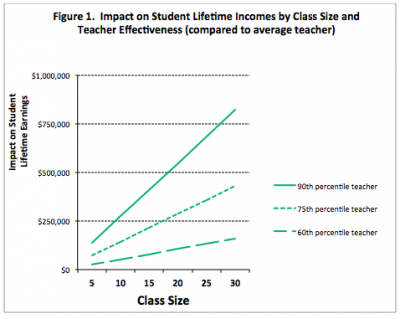 Occasionally omitted from the debate about the N.C. General Assembly’s decision to end teacher tenure in the state’s public schools is the importance of getting rid of the worst teachers as quickly as possible. In an interesting “Defining Ideas” article on effective teachers, the Hoover Institution’s Eric Hanushek explains how bad teachers create long-term problems for students.
Occasionally omitted from the debate about the N.C. General Assembly’s decision to end teacher tenure in the state’s public schools is the importance of getting rid of the worst teachers as quickly as possible. In an interesting “Defining Ideas” article on effective teachers, the Hoover Institution’s Eric Hanushek explains how bad teachers create long-term problems for students.
We now have a substantial number of studies that indicate clearly how much difference teacher effectiveness makes to student outcomes. In one study of mine, teachers near the top of the quality distribution got an entire year’s worth of additional learning out of their students compared to those near the bottom. That is, a good teacher will get a gain of 1.5 grade level equivalent while a bad teacher will get 0.5 year during a single academic year. Importantly, this analysis considered kids just from minority and poor inner-city families, indicating that family background is not fate and that good teachers can overcome deficits that might come from poorer learning conditions in the home. …
… Perhaps the most valuable way to see differences for the subsequent discussion of salaries is to calculate the impacts of effective teachers on the future earnings of students. A teacher who raises the achievement of a student will tend, other things being equal, to raise earnings throughout that student’s work life. We can in fact calculate the economic impact on the student from analyses of how achievement translates into higher incomes. Using 2010 earnings, for example, a teacher in the seventy-fifth percentile would on average raise each student’s lifetime income by somewhat more than $14,300 when compared to the average teacher. (All calculations are based on present values at the time of high school graduation where future incomes are discounted at 3 percent per year). But, this is not fully what the seventy-fifth percentile teacher contributes, because each student in the class can expect the same enhanced income. Thus, with a class of twenty-five students, this teacher would add $358,000 in future income compared to an average teacher.
Figure 1 shows the total contribution of teachers at the sixtieth, seventy-fifth, and ninetieth percentile of teacher effectiveness with varying class sizes. Excellent teachers add over $800,000 to the future incomes of students in a class of thirty. Even a teacher just above average at the sixtieth percentile would add over $100,000 to a class of twenty students.
These are calculations for each school year. Each and every year throughout their careers that these above-average teachers are teaching adds hundreds of thousands of dollars to their students. They also parallel a recent set of direct estimates of income effects that comes from linking teacher “value-added” to income tax records.
But, there is the darker side. Below-average teachers are subtracting from student earnings at a similar rate. The tenth percentile teacher, compared to an average teacher, subtracts over a half million dollars per year for each twenty students he or she teaches. For the tenth, twenty-fifth, and fortieth percentile teacher, one simply has to put a minus sign in front of the values seen in figure 1.


